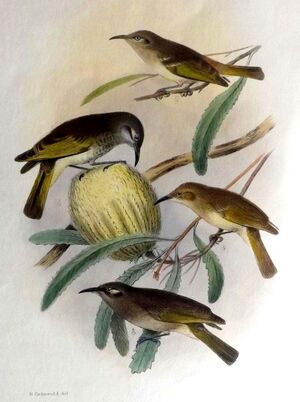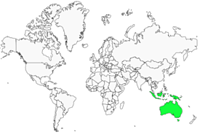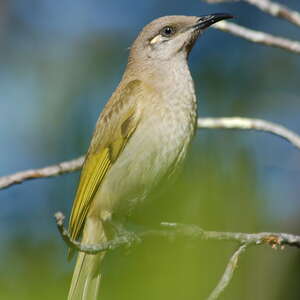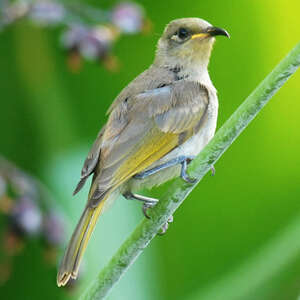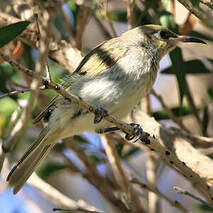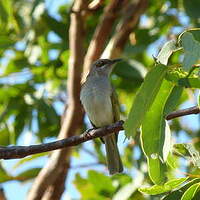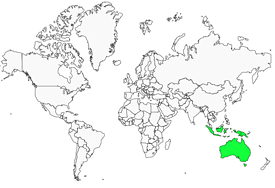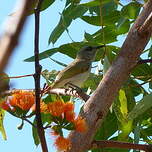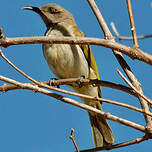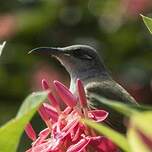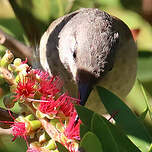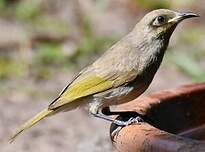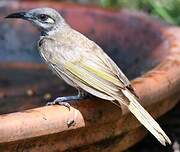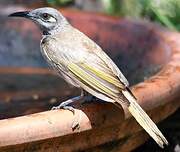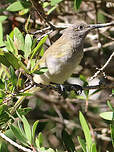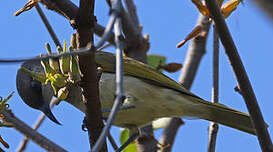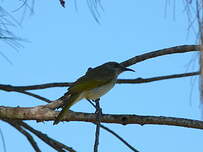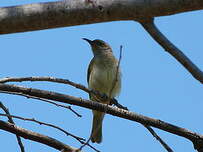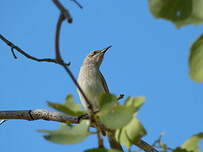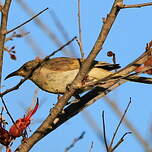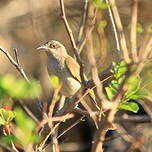Brown Honeyeater
Lichmera indistincta - Méliphage brunâtre
Identification
Subspecific information 5 subspecies
- Lichmera indistincta indistincta (w, c and n Australia)
- Lichmera indistincta limbata ()
- Lichmera indistincta nupta (Aru Is.. sw of New Guinea.)
- Lichmera indistincta melvillensis (Tiwi Is.. off nc Australia.)
- Lichmera indistincta ocularis (s New Guinea and e Australia)
Foreign names
- Méliphage brunâtre,
- Mielero pardo,
- papa-mel-castanho,
- Braunhonigfresser,
- barna mézevő,
- Parkhoningeter,
- Succiamiele bruno,
- brun honungsfågel,
- Brunhonningeter,
- medárik hnedý,
- medosavka hnědavá,
- Brun Honningæder,
- harmaavihermesikko,
- menjamel bru,
- miodojadek brązowy,
- Бурая лихмера,
- Isap-madu australia,
- サメイロミツスイ,
- 褐岩吸蜜鸟,
- 褐岩吸蜜鳥,
Habitat
Forest : Subtropical/Tropical Moist Lowland, Subtropical/Tropical Mangrove Vegetation Above High Tide Level ; Savanna : Dry, Moist ; Shrubland : Subtropical/Tropical Moist, Mediterranean-type Shrubby Vegetation ; Wetlands (inland) : Permanent Rivers/Streams/Creeks (includes waterfalls), Bogs, Marshes, Swamps, Fens, Peatlands ; Rocky areas (eg. inland cliffs, mountain peaks) : ; Artificial/Terrestrial : Rural Gardens, Urban Areas
Threats - protection
IUCN conservation status
Extinct
Threatened
Least
concern
concern
Extinc
in the Wild
in the Wild
Near
threatened
threatened
Not
evaluated
evaluated
EX
EW
CR
EN
VU
NT
LC
NE
Sources of information
- Birds of Australia, Peter Rowland
- Birds of Asia and Australia, David Alderton
- Hanbook of the birds of the world - Vol 15, del Hoyo J., Elliott A. Christie D.
- ARKive, Christopher Parsons
- Avibase, Lepage Denis
- Birds in backyards, Birds Australia and Australian Museum
- HBW Alive,
- Wikipedia (English version),
- IOC World Bird List (v14.1), Gill, F and D Donsker (Eds). 2024-04-18.
Other sources of interest
- Accipitriformes
- Aegotheliformes
- Anseriformes
- Apodiformes
- Apterygiformes
- Bucerotiformes
- Caprimulgiformes
- Cariamiformes
- Casuariiformes
- Charadriiformes
- Ciconiiformes
- Coliiformes
- Columbiformes
- Coraciiformes
- Cuculiformes
- Eurypygiformes
- Falconiformes
- Galliformes
- Gaviiformes
- Gruiformes
- Leptosomiformes
- Mesitornithiformes
- Musophagiformes
- Nyctibiiformes
- Opisthocomiformes
- Otidiformes
- Passeriformes
- Pelecaniformes
- Phaethontiformes
- Phoenicopteriformes
- Piciformes
- Podargiformes
- Podicipediformes
- Procellariiformes
- Psittaciformes
- Pterocliformes
- Rheiformes
- Sphenisciformes
- Steatornithiformes
- Strigiformes
- Struthioniformes
- Suliformes
- Tinamiformes
- Trogoniformes

